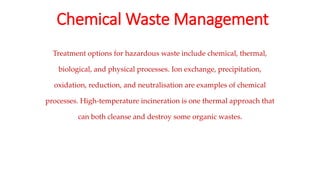
chemical waste management.pptx
- 1. Chemical Waste Management Treatment options for hazardous waste include chemical, thermal, biological, and physical processes. Ion exchange, precipitation, oxidation, reduction, and neutralisation are examples of chemical processes. High-temperature incineration is one thermal approach that can both cleanse and destroy some organic wastes.
- 2. Classification of chemical waste • Corrosive • Toxic • Flammable • Reactive Waste management are done for: For correct identification and characterization of hazardous waste To prevent the hazardous waste to enter in the environment
- 3. https://youtu.be/mRUrL5uDVNA https://youtu.be/f9zkRa4tG-g (hazardous waste management) https://youtu.be/eHrZi9ikmeE https://youtu.be/_-UXFY5iNME https://youtu.be/IlGjOpRffLc
- 4. Open dumping: In this technique, garbage is disposed of in open, low-lying areas remote from the city. This process is not eco-friendly. Sanitary landfill: This technique involves packing and dumping the waste everyday at the location, then covering it with earth to keep rodents and insects out of the landfill. Municipal Solid Waste is most frequently dumped openly. Municipal solid waste disposal is most frequently and widely used in an open dump. Due to open burning, groundwater and surface water contamination, soil pollution, and a decline in the amount of flora, open dumps harm the ecosystem.
- 5. • Incineration at sea is considered to be ocean dumping because the emissions from the stack will deposit into the surrounding ocean waters. The Ocean Dumping Ban Act of 1988 banned the dumping of industrial wastes, such as those previously permitted for incineration at sea
- 6. • Industrial waste, agricultural runoff, pesticides, and human sewage can all spur a HAB event. People are exposed to HAB toxins from eating contaminated fish and shellfish. These toxins can cause dementia, amnesia, other neurological damage, and death
- 7. A place where waste is dumped is referred to as a landfill site, tip, dump, rubbish dump, garbage dump, or dumping ground. Although the routine burying of waste with daily, landfills are the oldest and most popular method of waste disposal.
- 8. • Landfilling is not regarded as the final method of disposing of solid waste, but rather as a waste treatment process with its own inputs and outputs. Essentially, land filling entails the uncontrolled decomposition of biodegradable trash together with the long-term storage of inert materials. • •Incineration is a waste management technique that involves combusting waste-related chemicals. Waste-to-energy facilities are the usual name for industrial waste incineration plants. The term "thermal treatment" refers to incinerating waste and other high- temperature waste treatment methods.
- 10. Incineration It is a type of waste disposal method in which hazardous and toxic waste is burnt at high temperature Liquid injection incinerator for organic solvent Rotary kiln incinerator for solid organic compound Energy Recovery: The steam generated in incineration process is converted in to electrical energy or used for heating buildings
- 11. Concern about Incineration Process Advantages: Integrated solution to waste management Conservation of fossil fuels resources Immobilization of toxic and heavy metals Disadvantage: Expensive Causes air pollution Ash contain high level of dioxin, lead, cadmium and other toxic material which is threat for environmental contamination
- 12. Stabilization/Solidification •Organic and inorganic salts are treated by converting the hazardous waste in to an inert physically stable mass(stabilization). •This treated waste should have a very low leachability sufficient to allow for remote burial •Cement based matrix incorporating a special adsorber/blinder combination can be made and standardized up to industrial level in to various sizes.
- 13. Unknown /Unlabeled Chemical Waste Physical Parameters: a) State: Liquid/Solid/Gas b) pH c) Density d) Boiling Point e)Melting point f) Solubility in polar and non polar solvent(water, alcohol, acetone, benzene, toluene, cycloheaxane and acetonitrile)
- 14. Unknown /Unlabeled Chemical Waste Chemical Parameters: a) Elemental composition b) IR spectral analysis c) GC/HPLC/MS analysis( for organic compound) d) AAS/ICP
- 15. Side selection for disposal An ideal disposal area is one with deep soil, free from loose rocks,where trenches and pits can be dug easily and in which the risk of fire is negligible. In selecting a permanent disposal site following should be avoided: • Location near high energy electromagnetic transmitter • Location along established air traffic route •Area with high water table,shallow subsurface,rock strata and saturated clay soil. •Try to avoid area near rivers, lakes,floodpaints,highly populated and aquifer zones
- 16. Sanitary Landfills •In sanitary landfills waste disposal is regulated and controlled and refuse is covered with a layer of dirt and soil •An impermeable clay or plastic lining underlies to prevent the seepage of toxic material in to the ground water •Layer of clay or plastic form base of landfill •Prevents hazardous chemicals(oil,chemicals,metals etc) from leaching in to soil •Drainage pipes may be added to remove leachates